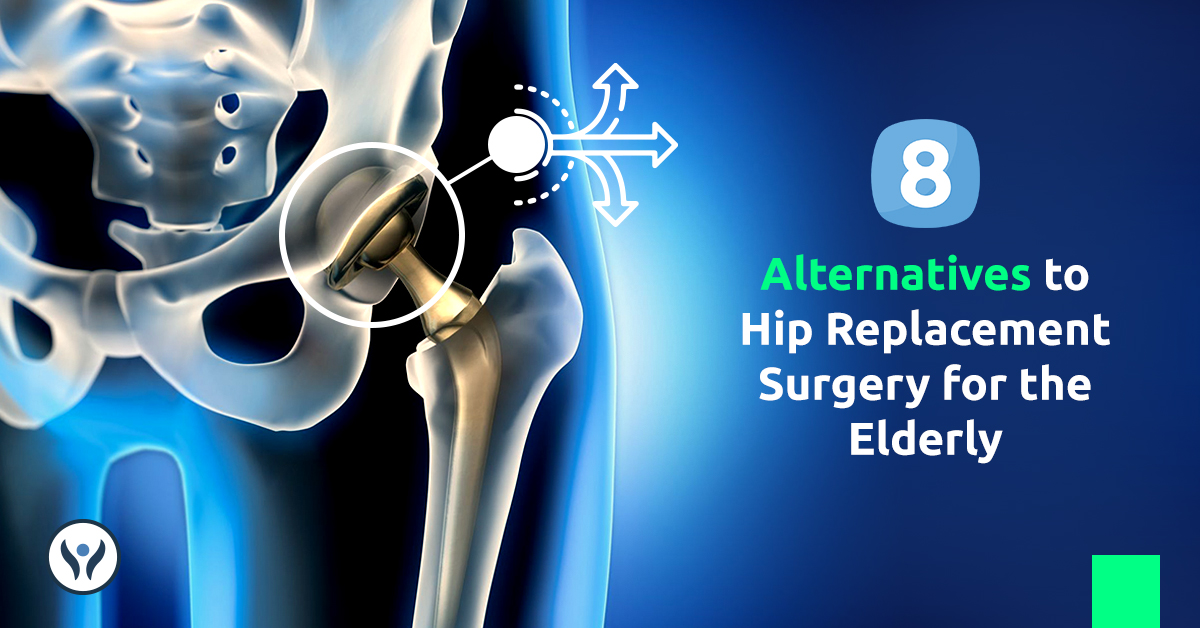Are you an elder struggling with hip pain and contemplating going through hip replacement surgery? Though hip replacement surgery can be a viable option for severe cases, it is crucial to first explore non-surgical alternatives. In this blog post, we will delve into several alternatives to hip replacement surgery for elderly individuals that have the potential to alleviate pain and enhance mobility.
8 Non-Surgical alternatives and improvements to hip replacement surgery
Physical Therapy
Physical therapy is a non-surgical method of treatment that aims to enhance muscle strength, flexibility, and movement. By tailoring exercise plans to address the unique requirements of elderly individuals experiencing hip pain, physical therapists can alleviate discomfort, enhance the range of motion, and ultimately improve the overall functioning of these patients.
Medications
There are specific medications available to help control hip pain and reduce inflammation. Nonsteroidal anti-inflammatory drugs (NSAIDs) like ibuprofen and naproxen can offer temporary relief. However, it is crucial to seek advice from a healthcare provider prior to taking any medication, as they may have potential side effects and interact with other medications.
Injections
If you are experiencing inflammation and pain in your hip joint, one solution is to receive corticosteroid injections. These injections are directly administered into the joint and have the ability to reduce inflammation and relieve pain temporarily. However, it is important to note that recurring injections may be necessary. Another alternative is hyaluronic acid injections, which aid in lubricating the joint and diminishing friction.
Assistive Devices
Using assistive devices such as a cane or walker can help alleviate hip pain by reducing pressure and strain on the joint. These devices can provide support and stability while walking, making it easier for individuals with hip pain to remain mobile and active.
Weight Management
Maintaining a healthy weight can help reduce stress on the hip joint and alleviate pain. Weight loss, through a combination of diet and exercise, can help reduce inflammation and improve overall joint function.
Lifestyle Modifications
Making certain lifestyle changes can also help manage hip pain. Avoiding high-impact activities and choosing low-impact exercises such as swimming or cycling can help protect the hip joint. Using proper body mechanics and avoiding excessive sitting or standing can also help reduce hip pain.
Alternative therapies
Certain alternative therapies, such as acupuncture, chiropractic care, and massage therapy, may provide temporary relief for hip pain. It is important to consult with a healthcare professional before trying these therapies to ensure they are safe and appropriate for individual needs.
Orthobiologics
Orthobiologic treatments are designed to utilize the body’s own cells in order to promote the healing of injuries. This innovative form of regenerative medicine offers a non-surgical approach to replacing damaged tissues with healthier ones.
At Medica Stem Cells, you have the option to choose between two popular orthobiologic methods as alternatives to hip replacement surgery for the elderly: cell-based therapies and platelet-rich plasma therapy (PRP). These treatments can be done on an outpatient basis, so you can return home immediately after the procedure. In addition, they offer the advantages of being less painful, minimally invasive and having a quicker recovery time compared to traditional treatments. Read more al furjan villas for rent
-
PRP therapy:
Platelets, which are protective cells in our bodies, are responsible for preventing bleeding in the event of an injury. During a PRP procedure, the doctor will collect a blood sample from the patient and send it to the laboratory to isolate the platelets. Once the platelets have been processed and prepared, they are injected into the injured hip to initiate healing.
Platelets serve important functions in the body, including the stimulation of new tissue growth by releasing 10 growth factors and attracting healing elements. They also attract healing cells from the blood to promote early recovery and create fibrin, a web-like structure that facilitates the growth of new cells and tissues.
The PRP procedure can typically be completed within 45 minutes. The amount of platelets present in a patient’s blood can impact the speed of their recovery. As a result, PRP has become a favoured alternative to hip replacement among athletes seeking treatment for spine, orthopaedic, and sports-related injuries for over two decades.
-
Cell-based therapy
The initial option, referred to as stem cell therapy, involves the utilization of stem cells to replace the affected tissues. These cells are acquired from the patient’s blood, fat, or bone marrow and are then prepared before being injected into the injured region.
The injection of these stem cells aids in accelerating the healing process and repairing the damaged area of the hip. The procedure known as Bone Marrow Aspirate Concentrate (BMAC) involves obtaining bone marrow aspirate from healthy and sizable bones and administering it to the injured hip. This healthier bone marrow works towards repairing the damaged hip and facilitating the healing process.
This therapy typically takes approximately 2 hours to complete, and you can return home a few hours after the treatment is finished.
Final Thoughts
Elderly people suffering from hip pain have various alternatives to hip replacement surgery. Instead of going under the knife, they can opt for non-surgical methods like physical therapy, medication, injections, and making lifestyle changes. It is crucial to consult a healthcare expert to devise the most suitable plan according to each person’s situation. Keep in mind that surgery should only be considered as a final option. Seize control over your hip pain and investigate non-surgical options for a higher standard of living!




